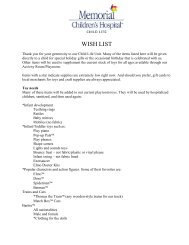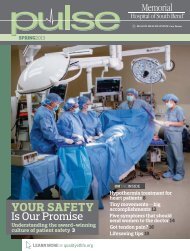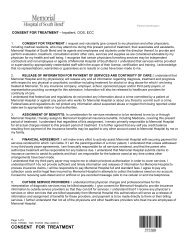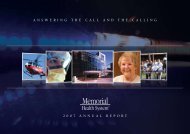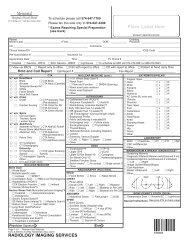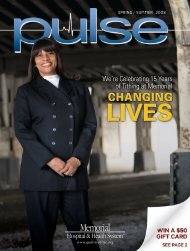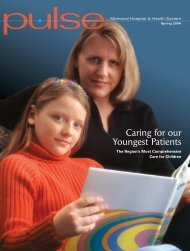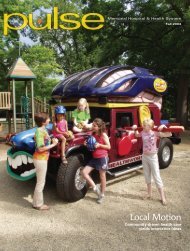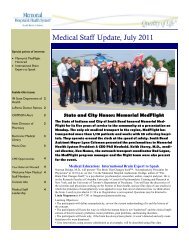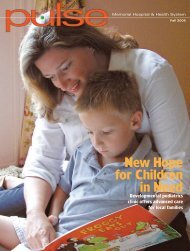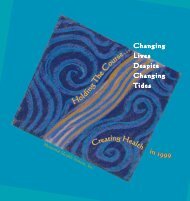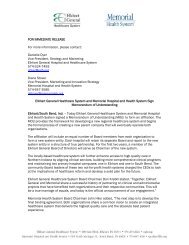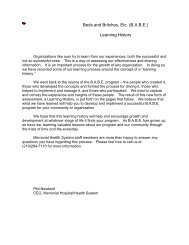First Impressions - Memorial Hospital of South Bend
First Impressions - Memorial Hospital of South Bend
First Impressions - Memorial Hospital of South Bend
- No tags were found...
Create successful ePaper yourself
Turn your PDF publications into a flip-book with our unique Google optimized e-Paper software.
HEALTHY EATSFruit and Yogurt SaladYour tummy will thank you for this one: A refreshing blend <strong>of</strong> tangyyogurt, tossed fruit and tempting toasted coconut. Choose yogurt madewith live cultures to promote a healthy stomach and active digestion.1 Tbsp. shredded unsweetened coconut*1 c. fat-free plain yogurt, preferably Greek-style½ tsp. vanilla extract2 Tbsp. honey1 medium banana, sliced ½-inch thick1 c. sliced fresh strawberries*Use toasted coconut if available and skip the toasting step.Preheat oven to 325 degrees. Spread coconut on small baking sheet.e Bake for 5 to 7 minutes or until lightly browned. Remove frombaking sheet and set aside.Stir yogurt, vanilla and honey together in a bowl. Divide bananar and strawberries between two bowls. Top each with half the yogurtmixture. Sprinkle each serving with half <strong>of</strong> the coconut.Makes 2 (1¼ cup) servingsNutritional information per serving:220 calories, 2 g total fat, 8 g protein, 45 g carbohydrates,2.5 mg cholesterol, 104 mg sodium, 3 g dietary fiberHow Sweet It IsGood news for dedicated sweet tooths: ACornell University study found that you may bemore successful than others at parlaying thatpreference for sugary snacks into fruit-basedones. Fruit snacks provide the same sweetnessyou love but with more nutrients—and none <strong>of</strong>the added sugar or excess calories.For fruits with peak nutritional benefit,check out these tips from the U.S. Department<strong>of</strong> Agriculture:• Opt for whole or cut fruit whenever possible.It provides more dietary fiber than juice.• Pick fruits high in potassium, such as bananas,dried peaches and apricots, cantaloupe,honeydew melon and orange juice.• Canned fruits can be a convenient choice, butbe sure to choose fruit packed in 100 percentfruit juice or water, not syrup.• Eat a variety <strong>of</strong> fruits—you’ll benefit bygetting an array <strong>of</strong> nutrients.SPRING / SUMMER 2010 › www.quality<strong>of</strong>life.org03
Surpassing GoalsSince the Sunburst Races began in 1984,participation has doubled. This year,more than 8,100 participated in thevarious events: marathon, halfmarathon,half-marathon wheelchair,10K, 5K, fitness walk and family walk.<strong>Memorial</strong> <strong>Hospital</strong>, one <strong>of</strong> the majorsponsors <strong>of</strong> the event since 1990, wasrepresented by 473 runners and walkers.The aim <strong>of</strong> the Sunburst Races, whichbegin in downtown <strong>South</strong> <strong>Bend</strong> andend in the football stadium on theUniversity <strong>of</strong> Notre Dame, is toincrease the health and fitness <strong>of</strong>the people <strong>of</strong> <strong>South</strong> <strong>Bend</strong> and itssurrounding areas. One participant, anactive chemo patient, participated inthe 5K fitness walk with his family, andhe already has goals for this year. Heplans to enter the 5K run during theSaturday, June 5, 2010, race.Registration information for2010 is available online atwww.sunburstraces.org. •<strong>Memorial</strong>’s new surgery suites <strong>of</strong>fer some <strong>of</strong> the most advanced care in the region.Fulfilling Our Promise to RedefineHealth CarePatients, as always, were the focus <strong>of</strong> <strong>Memorial</strong>’s new Surgical Suiteexpansion, which increases the availability <strong>of</strong> services to those in need. Ouradvanced capabilities and increased space ensure that more surgeries can beperformed on a daily basis. Even what may seem like small details, such ashigh-speed washers for linens and clothing, will facilitate safe, efficientturnaround times, thereby leading to increased flexibility in scheduling.From the most technological advances to the most basic and everydayconsiderations, <strong>Memorial</strong> is motivated by the patients’ needs.In celebration, Surgical Services held a grand opening <strong>of</strong> the new suites.A special evening reception included the <strong>of</strong>ficial “unmasking” <strong>of</strong> the suites,complete with a 6-foot-wide surgical mask, special speakers, refreshmentsand tours. Tours for <strong>Memorial</strong> Team Members also took place, along with aspecial event for families and friends <strong>of</strong> <strong>Memorial</strong>’s Surgical ServicesDepartment. •PULSE › <strong>Memorial</strong> Health System › 574-647-6800A Visit fromFootball RoyaltyChildren, parents and <strong>Memorial</strong> Team Members alikeenjoyed a visit from football legend and former DallasCowboys quarterback Troy Aikman during this year’sCollege Football Hall <strong>of</strong> Fame enshrinement weekend.Aikman visited children in <strong>Memorial</strong> Children’s <strong>Hospital</strong>,and “big kids” in <strong>Memorial</strong>’s first-floor Rehabilitation gym,generously signing autographs and posing for picturesalong the way. •Football legend Troy Aikman visited <strong>Memorial</strong> Children’s <strong>Hospital</strong> aspart <strong>of</strong> the College Football Hall <strong>of</strong> Fame’s enshrinement festivities.04
NEWS BRIEFS<strong>Memorial</strong> Children’s <strong>Hospital</strong>When they can’t be there in person,<strong>Memorial</strong> Children’s <strong>Hospital</strong>’s Now ISee You program allows new mothersand fathers to see their baby via alaptop-based webcam. This separationcan happen when moms are stillrecovering in a different department,or when a baby is transferred to<strong>Memorial</strong> Children’s <strong>Hospital</strong> fromanother hospital.Health Foundation. “To help lessenthis hardship on families, <strong>Memorial</strong>Health Foundation partnered withthe Holm family and the Run Baby,Baby Run event to help bring theNow I See You program to <strong>Memorial</strong>Children’s <strong>Hospital</strong>.”Through this webcam, new parentscan see their infant in real time, alongwith their child’s caregivers, 24 hoursa day, seven days a week. It’s asolution that <strong>of</strong>fers peace <strong>of</strong> mindduring a difficult time in the lives <strong>of</strong>these young families. •explains Chris Endres, director“We know how hard it must be fornew moms and dads to be separatedfrom their newborn,” says Reg Wagle,senior vice president, <strong>Memorial</strong><strong>Memorial</strong>’s new Now I See Youprogram helps familiesstay connected while momor baby is recovering.CelebratingEmployee WellnessThe American Heart Associationrecognized <strong>Memorial</strong> <strong>Hospital</strong> as aStart! Fit-Friendly Company forpromoting physical activity andhealth in the workplace.“Time constraints and jobresponsibilities are employees’biggest obstacles to exercising,” saysLaura Guy <strong>of</strong> the American HeartAssociation. “That’s why the Start!Fit-Friendly Companies programencourages employers to allowemployees to walk while at work.”<strong>Memorial</strong> has implemented a number<strong>of</strong> options to encourage healthyliving habits, such as on-site walkingroutes, healthy food options in thecafeteria, an annual employee healthrisk assessment, online tracking toolsand PATH (People Achieving TotalHealth), a comprehensive programthat rewards employees for thesimple things they do each day toimprove their health. •<strong>Memorial</strong> Pioneers ElectronicMedical Record Product<strong>Memorial</strong> has partnered with RaintreeSystems, Inc., out <strong>of</strong> California todevelop Quick Charts s<strong>of</strong>tware, anelectronic medical record system thatwill be used in <strong>Memorial</strong>’s MedPoint®express SM clinics.The clinics, located in Walmart andMartin’s stores, <strong>of</strong>fer convenient andaffordable basic medical care. TheQuick Charts system affords greaterefficiency for the nurse practitionersproviding care, enabling them tospend more time with each patient.“Quick Charts is the onlycommercially available productintended for use in a retailenvironment by a single medicalprovider without clerical support,”<strong>of</strong> <strong>Memorial</strong>’s MedPoint expressclinics. “The Quick Chart model isperfectly tailored to the needs <strong>of</strong>our patients at MedPoint express.”Endres managed the project with thehelp <strong>of</strong> clinic supervisor RyannDeMoss.The system has proved so beneficialthat Raintree and <strong>Memorial</strong> willmarket the program to other clinics.To learn more about MedPoint express,visit www.medpointexpress.com. •SPRING / SUMMER 2010 › www.quality<strong>of</strong>life.org05
The NextGeneration <strong>of</strong>MedicineMore than 50 local teenstook part in <strong>Memorial</strong>’sinaugural Mini-MedicalUniversity for Teensprogram. This exciting twoweeksummer programallows high school studentsto explore the thrillingworld <strong>of</strong> medicine.Healing in HaitiOn Feb. 2, 2010, George Friend,M.D., and Mark Walsh, M.D., <strong>of</strong><strong>Memorial</strong> joined a medical teamflying to Milot, Haiti, northwest<strong>of</strong> Port-au-Prince, to run thesmall <strong>Hospital</strong> Sacre Coeur. Alsopart <strong>of</strong> the team were TeamMembers Dana Brackett, N.P.;Kyonna Charleston, R.N.; HenryDeLeeuw, M.D.; Donna Dickens,R.N.; Michelle Crawford, R.N.;Randy Ferlic, M.D.; Fred Ferlic,M.D.; Doug Gibson, R.N.; RickSkupski, M.D.; Ann Marie Thomas,R.N.; James Wierman, M.D.; andMike Yergler, M.D.James Kelly, M.D., medicaldirector <strong>of</strong> the ThoracicOncology Clinic, guidedthe teens through thedissection <strong>of</strong> a pig’s heart,and ophthalmologist SteveGerber, M.D., did the same withcows’ eyes. The group also helped“deliver a baby” with the help <strong>of</strong> alifelike mannequin and increased theirawareness <strong>of</strong> life as a disabled personduring a tour <strong>of</strong> the RehabilitationDepartment. Other trips includedvisits with the Child Life team anda hands-on tour <strong>of</strong> the LaundryDepartment, Radiology and <strong>Memorial</strong>’sMedFlight helicopter. They alsoworked together to solve a problemJames Kelly, M.D., leads students in the dissection <strong>of</strong> apig heart during <strong>Memorial</strong>’s Mini-Medical Universityfor Teens program.that was posed to them and, inteams, presented their solutionsto <strong>Memorial</strong>’s CEO and COO.After completing the program,students were awarded 40 out <strong>of</strong>72 hours <strong>of</strong> volunteer time neededfor a chance to be awarded a $1,000educational scholarship from<strong>Memorial</strong>’s Auxiliary.Interested in next summer’s program?Call Ambassador & Customer Servicesat 574-647-6495. •PULSE › <strong>Memorial</strong> Health System › 574-647-6800When they arrived, thedevastation was shocking.Dr. Walsh was put in charge <strong>of</strong>handling daily rounds and he andDr. Friend performed many <strong>of</strong> themore than 30 surgeries neededeach day. The team performedmore than 120 procedures duringtheir week <strong>of</strong> service.To learn more about theirjourney, visit their blog atwww.mdsinhaiti.blogspot.com.Car Seat SafetyIn just under four hours, Certified Child PassengerSafety Technician Wendy Nash, R.N., and a number <strong>of</strong>other pr<strong>of</strong>essionals from <strong>Memorial</strong> Children’s <strong>Hospital</strong>,checked 75 child car seats, replaced 65 unsafe seats andeven fitted a few families who came without seats.“It was fantastic to work with all <strong>of</strong> the organizationsthat sponsored this event: <strong>Memorial</strong> Children’s <strong>Hospital</strong>,<strong>Memorial</strong>’s Reach Out Club who funded the costs<strong>of</strong> the seats, and HealthWorks! Kids’ Museum,among others,” says Nash. “It was a huge successand we definitely met our goal, that kids leave ourevent riding safer than when they arrived!” •06
TakingTimetheMoving at the speed <strong>of</strong> safetyThe quicker a heart attack patient’sheart resumes normal blood flow, thebetter his or her chances for recovery.Therefore, <strong>Memorial</strong> <strong>Hospital</strong> hasdeveloped a precisely coordinatedplan to treat such patients, particularlythose with the most severe heartattacks, ST elevation myocardialinfarctions (STEMIs).The American Heart Association (AHA)gold standard for STEMI treatment is apercutaneous coronary intervention(PCI). This is the quick, effective clearing<strong>of</strong> arterial blockage with an angioplastyballoon and subsequent reinforcement<strong>of</strong> the artery with a stent.Members <strong>of</strong> <strong>Memorial</strong>’s code STEMI team prepare a patient for a PCI intervention.The AHA timeframe for PCI is 90minutes from the time a patiententers the hospital to inflation <strong>of</strong> theangioplasty balloon, which clears theblockage and enables blood flow. Inother words, 90 minutes from “doorto-balloon.”The entire process hingeson quick, effective identification <strong>of</strong> aSTEMI patient and coordination amonga goal-oriented team.laying groundworkThe moment a possible heart attackpatient enters <strong>Memorial</strong>, an EKG andother tests are administered. If thepatient has a STEMI, he is prepared andthe lab and cardiologist are activated.The earlier the team activates, thesooner treatment can begin.<strong>Memorial</strong> has steadily worked towardconsistently meeting the AHA goal.“We have been fine-tuning our processwith great success. Our mortality ratesare lower than national levels and ouraverage time is 78 minutes,” explainsCatherine Bringedahl, R.N., manager<strong>of</strong> <strong>Memorial</strong> <strong>Hospital</strong>’s cardiaccatheterization lab. But this successwas just the beginning.raising the barFour years ago, <strong>Memorial</strong> rewrote thedefinition <strong>of</strong> effective care, nowfocused on what Keith Sherry, M.D.,medical director for EMS andHelicopter Services, terms “call-toballoon”times. The clock starts themoment 911 is dialed and stops whenthe angioplasty balloon inflates.The key <strong>of</strong> call-to-balloon? Localadvanced life-support ambulancesperforming EKGs in the field, longbefore patients reach <strong>Memorial</strong>. IfSTEMI is confirmed, the teamactivates while the patient is in transit.These patients average an impressive53-minute door-to-balloon time.taking flightIn 2007, <strong>Memorial</strong> broadened theprogram to patients at outlyingreferral hospitals (those without PCIcapability) via MedFlight, <strong>Memorial</strong>’sair medical transport service,beginning with the Community<strong>Hospital</strong> <strong>of</strong> Bremen. The result? CodeSTEMI, an intricately coordinatedprogram utilizing MedFlight’scapabilities.“We stress moving at the speed<strong>of</strong> safety, with trust in the expertise<strong>of</strong> our colleagues and withoutduplication <strong>of</strong> efforts,” explainsMedFlight Program Manager RodneyLogan, R.N.“Achieving STEMI treatmenttimeframes within AHA standards, evenfor patients transferred from outlyinghospitals, is a real accomplishment. It’ssolid pro<strong>of</strong> <strong>of</strong> what’s possible withexcellent integration <strong>of</strong> multiple teams,representing different hospitals inseveral communities, all for the benefit<strong>of</strong> our mutual patients,” says Dr. Sherry.Thus far, <strong>Memorial</strong> has conducted threeCode STEMIs with the Community<strong>Hospital</strong> <strong>of</strong> Bremen, the most recentclocking in at 81 minutes from theirdoor to <strong>Memorial</strong>’s balloon. •SPRING / SUMMER 2010 › www.quality<strong>of</strong>life.org011
PULSE › <strong>Memorial</strong> Health System › 574-647-6800Matters“You should see aheart specialist.”These six words can throw anypatient into a whirlwind. Acardiologist? Where do I find aqualified cardiologist around here?<strong>of</strong>Since a third <strong>of</strong> all Americans willsuffer from heart disease, choosingthe right cardiologist is vital toproper care. Thankfully, the answerto these questions just becameeasier: <strong>Memorial</strong>’s AdvancedCardiovascular Institute (MACI),home to six preeminent cardiologists.FINDING A CARDIOLOGISTIn June 2009, Health Magazine gavetips to those seeking cardiologists. Findone with experience, they advised, andone with whom you are comfortable.Make sure he or she takes the time toknow you as an individual and knowyour case as unique.“<strong>Memorial</strong> and MACI have the besttrained,best-educated boardcertifiedcardiologists in the region,”says Raman Mitra, M.D., Ph.D., FACC.Graduates <strong>of</strong> preeminent universitiesworldwide, MACI cardiologists havepublished standard textbooks in theirfield and five are fellows <strong>of</strong> theAmerican College <strong>of</strong> Cardiology.While other specialists may say thatthey are certified in certain types <strong>of</strong>diagnostic testing, Health Magazinereminds you to check theirbackgrounds. For example, somedoctors may be able to “performtests,” but at MACI, the cardiologistsare also certified to read them.theHeart“We provide full service withexpertise and state-<strong>of</strong>-the-arttechnologies in all aspects <strong>of</strong>cardiology to our patients. We alsoprovide expedient and completereports and follow-ups to ourreferring physician practices,” explainsDaniel Meng, M.D., Ph.D., FACC.ADVANCED CAPABILITIES,NOW IN SOUTH BEND“Our doctors work together with thepatient to determine the bestpossible treatment,” says DarleneSmith, practice manager <strong>of</strong> MACI.This personal approach is key, explainsHealth Magazine, as is ensuring thatyour doctor has the experiencenecessary to perform whateverprocedure you may require. Studiesshow that patients whose doctorshave had more experience implantingcardiac defibrillators have fewercomplications.And with MACI nearby, patients neednot travel to distant metropolitancenters for top-notch care. MACIcardiologists also serve part time atsatellite branches in LaPorte, Elkhartand Plymouth.“We want to be where patients needus,” says Dr. Mitra, who is assigned parttimeto the Plymouth branch.In 2009, the main <strong>of</strong>fices <strong>of</strong> MACIwere renovated with the patient inmind. The entryway <strong>of</strong>fers a serene,relaxing environment. The patientrooms are spacious and well-lit. Andthe nursing pods facilitate moreefficient care.Introducing<strong>Memorial</strong>AdvancedCardiovascularInstituteAreas <strong>of</strong> Consultation:• Cardiac risk assessment• Chest pain evaluation• Cardiac causes <strong>of</strong> dyspnea• Acute and chronic coronaryartery disease• Assessment <strong>of</strong> cardiovascular risksfor TIA/stroke or claudication• Management <strong>of</strong> dyslipidemia• Atrial fibrillation management• Palpitations• Dizziness or syncope• Congestive heart failure includingreferral for cardiac transplantationand ambulatory ventricular assistdevices• Assessment for pacemaker anddefibrillator implantationInpatient andOutpatient <strong>Hospital</strong>Services Include:• Cardiac catheterization• Angioplasty and stenting• Transesophageal, intravascular andintracardiac echocardiography• Electrophysiology study• Catheter ablation forsupraventricular tachycardia• Catheter ablation for ventriculartachycardia• Catheter ablation for atrialfibrillation• Implantation <strong>of</strong> pacemakersand defibrillators• Laser lead extraction• Tilt testing• Coronary CT imaging andinterpretation• Cardiac magnetic resonanceTo learn more about <strong>Memorial</strong>Advanced Cardiovascular Institute,visit www.<strong>Memorial</strong>MedicalGroup.org.012
COMPREHENSIVE CAREEach person is unique; each heartis unique. And depending on yourparticular condition, you mayneed a particular subspecialist.Electrophysiologists like Dr. Mitraand Sean Halleran, M.D., haveadditional education to treatabnormal heart rhythms. MACI islucky to have two such specialists,particularly since the Heart RhythmFoundation census calculated thereis only one electrophysiologist forevery 263,690 Americans.Omar Ali, M.D., FACC, and Dr. Mengare interventional cardiologists,dealing with catheter-basedtreatment <strong>of</strong> structural heartdiseases, such as angioplasties andthe insertion <strong>of</strong> stents.As a diagnostic cardiologist, AndrewFiedler, M.D., M.Div., FACC, workswith valvular heart disease, 3-Dechocardiographical imaging andpreventive cardiology. His fellowdiagnostic cardiologist, BrenoPessanha, M.D., FACC, FASE, is boardcertifiedin echo and nuclearcardiology and board-eligible incardiac CT. He is also able to performcardiac MRI, due to his advancedcardiac magnetic resonance training.Dr. Pessanha is the onlycardiologist in the areawith this training, which actively aidsin the imaging process.The team is completed by its trainednursing staff including Daniel Tom, N.P.,who is certified by the AmericanCollege <strong>of</strong> Sports Medicine and has 21years <strong>of</strong> experience in diagnosticstress testing.“The key is that we are an incrediblybalanced team,” says Dr. Mitra. “MACIprovides our community with quality,compassionate, accessible and costeffectivehealth care for people withnearly any type <strong>of</strong> cardiovascularissue. This type <strong>of</strong> specialization isn’tusually found in a community oursize—we are lucky.” •Omar Ali,M.D., FACCInterventionalCardiologyAndrew Fiedler,M.D., M.Div., FACCDiagnosticCardiologyBreno Pessanha,M.D., FACC, FASEDiagnosticCardiologySean Halleran, M.D.CardiacElectrophysiologyRaman Mitra,M.D., Ph.D., FACCCardiacElectrophysiologyDaniel Meng, M.D.,Ph.D., FACCInterventionalCardiologySPRING / SUMMER 2010 › www.quality<strong>of</strong>life.org013
Out<strong>of</strong> theBlueOne family’s journeywith juvenile diabetesPULSE › <strong>Memorial</strong> Health System › 574-647-6800Five years ago Jill and Erik Lyon returned from a weeklongvacation to find their young son, Zachary, moroseand withdrawn.“He was acting strange for two weeks, but we didn’tthink much <strong>of</strong> it. We thought he was just reacting toour absence, to staying with his grandmother,” explainsJill. Yes, he was drinking more water and juice, but thattoo seemed to reflect his change in schedule morethan any medical issue.Knowing the SignsType 1 diabetes, like Zachary’s, is most common inchildren and young adults, but can appear at any age.Approximately 15,000 people under the age <strong>of</strong> 20 arediagnosed in the United States each year. And, like theLyon family, you need not have a family history <strong>of</strong>diabetes to be at risk. Symptoms <strong>of</strong> Type 1 diabetesmay include:• Being very thirsty or hungry• Urinating <strong>of</strong>ten• Feeling tired• Unexplainable weight loss• Slow-healing wounds or sores• Dry, itchy skin• Loss <strong>of</strong> sensation or tingling inyour feet• Blurry eyesightA blood test can show if you or your child hasdiabetes. If diagnosed, insulin injections are therequired form <strong>of</strong> treatment.Zachary Lyon, now 10, plays computer games and is learning the guitar,unhindered by his juvenile diabetes.However, when the normally chatty and straightforwardZachary didn’t snap out <strong>of</strong> his blue mood after a fewdays, his mother called her family doctor. “Can a 5-yearoldbe depressed?” she asked. The doctor was skeptical,but advised that she bring Zachary for a check-up in acouple <strong>of</strong> days.Zachary couldn’t wait. Tired, thirsty and silent, he wasunable to stay awake. “I just remember being so sleepy,”Zachary recalls. On March 2, 2005, Jill rushed him to thedoctor, who then transferred him to the <strong>Memorial</strong>Pediatric Intensive Care Unit. Zachary was immediatelydiagnosed with Type 1 diabetes, formerly known asjuvenile diabetes.With no family history <strong>of</strong> diabetes, Jill felt as though she’dbeen thrown in deep water, but the diabetes specialistsat <strong>Memorial</strong> Children’s <strong>Hospital</strong> were ready to help. WhileZachary was still in the hospital, the whole family metwith Noreen Mackiewicz, R.N., CDE, Pediatric DiabetesEducator, who taught them the basics <strong>of</strong> Zachary’s care.“We first teach [parents] what we call ‘survival skills,’ ”explains Mackiewicz. These skills include giving injections,checking blood sugar, managing meal plans and countingcarbohydrates. Families are also provided with thenecessary contact information in case <strong>of</strong> an emergency.Mackiewicz becomes the “go-to” person for families likethe Lyons.014
“She was really great,” says Jill <strong>of</strong>Mackiewicz. “She never made us feelstupid; she was patient, waiting andlistening. And we could always callher.” The family was in the hospital,learning from Mackiewicz, for fourdays before Zachary was allowed toreturn home. Jill vividly rememberslearning to give insulin shots. Her firstpatient? An orange.“They were ready learners,”Mackiewicz remembers <strong>of</strong> theLyons. “Zachary was amazing. Weall took to calling him ‘the littlepr<strong>of</strong>essor’ because he was such abright, precocious child. He was only5 years old, but he read theinformation about carb counting andwas asking the nurses and doctorsquestions as soon as he was able.”“That’s how we knew he was feelingbetter,” says Jill, “He just startedtalking again, nonstop.”The adjustment to using insulinwasn’t easy, but Zachary handled itwith aplomb. In first grade, hetransferred to using a pump, whichhe prefers. “The pump is a lot easier,”he explains. “With shots I had t<strong>of</strong>igure out how many units <strong>of</strong>insulin—it was almost impossible toget perfect. The pump will tell you, itwill reduce when it’s supposed to.”The adjustment was also social.Zachary didn’t know any otherchildren with diabetes, and had tolearn to explain his condition to hispeers. Explanations proved to bechallenging. “Most other kids justthink I’m allergic to sugar,” he says.Type 1 diabetes is more complex thana simple allergy. Also called insulindependentdiabetes, the incurabledisease is a result <strong>of</strong> the pancreas notproducing insulin, the hormone thathelps glucose enter cells, giving themenergy. Without insulin, the bloodretains too much glucose. If untreated,these high glucose levels can lead toproblems with the eyes, heart, kidneys,nerves, gums and teeth. Thosediagnosed with Type 1 diabetes, likeZachary, need to take doses <strong>of</strong> insulinfor the rest <strong>of</strong> their life, regulatingtheir blood sugar carefully.Living with diabetes involves thewhole family, says Mackiewicz.Thankfully, Zachary not only has veryinvolved parents, but his youngersister, Alex, is also part <strong>of</strong> his dailylife and health. A few years youngerthan her brother, Alex understandsthe gravity <strong>of</strong> his condition, butsometimes the siblings find a lighterside to the difficult situation.“Sometimes we joke and say thatZack’s pump is a phone,” Alex says.“When it beeps, he’ll pull it out <strong>of</strong> hispocket and hold it up to his ear likehe’s listening.”Every year, the Lyon family returnsto <strong>Memorial</strong>’s Pediatric IntensiveCare Unit to see Mackiewicz andher fellow nurses, bearing flowersand smiles. And, like all diabetespatients, they are waiting for a curefor the disease.To learn more about the searchfor a cure for diabetes, visit theJuvenile Diabetes ResearchFoundation Web site, www.jdrf.org,or to learn about the juvenile diabetesprogram at <strong>Memorial</strong>, visit www.<strong>Memorial</strong>Childrens<strong>Hospital</strong>.org. •Knowing theDifference: <strong>Memorial</strong>Children’s <strong>Hospital</strong>Children are not small adults. Thisstatement is never more true thenwhen a child needs medical care.Children need specialized healthcare, focused on their uniquedevelopmental needs and involvingtheir parents in all aspects.<strong>Memorial</strong> Children’s <strong>Hospital</strong> <strong>of</strong>fershigh-quality specialized care in avariety <strong>of</strong> areas. By providing thisresource locally, families have thecomfort <strong>of</strong> knowing their childreceives first-class care close tohome. In addition to pediatricdiabetes care, these pediatricspecialties include:• Pediatric Intensivists• Neonatologists• Pediatric Infectious Disease• Pediatric Pulmonologists• Developmental Pediatrics• Pediatric <strong>Hospital</strong>ists• Pediatric Hematology/Oncologists• Maternal-Fetal MedicineSpecialists• Child Life Specialists• Pediatric Emergency TransportServices• Pediatric Physical Therapists• Pediatric Speech Therapists• Pediatric Occupational TherapistsTo learn more about <strong>Memorial</strong>Children’s <strong>Hospital</strong>, visit www.<strong>Memorial</strong>Childrens<strong>Hospital</strong>.org.SPRING / SUMMER 2010 › www.quality<strong>of</strong>life.org015
This year marks the 10th birthday for <strong>Memorial</strong>Children’s <strong>Hospital</strong>’s HealthWorks! Kids’ Museum.A radically different model in the field <strong>of</strong> healtheducation, our mission is “infectiously contaminatingkids <strong>of</strong> all ages everywhere to learn, have fun andmake great life choices ... Let the epidemic begin!”A decade <strong>of</strong>infectious educationFOUNDING PARTNERS:Harry and Jeanette Weinberg FoundationDennis and Mary Lou SchwartzJames and Julia SchwartzThe Shields Family:William S. and Kathryn L. Shieldsand Barbara Shields ByrumE. Blair and Jane J. Warner and Family<strong>Memorial</strong> <strong>Hospital</strong> AuxiliaryJunior League <strong>of</strong> <strong>South</strong> <strong>Bend</strong><strong>Memorial</strong> Health FoundationAnd, according to recent studies, we have beenstupendously successful: Over 90,000 people had aHealthWorks! experience in 2009 alone. In 2006, thenon-pr<strong>of</strong>it organization Mid-continent Research forEducation and Learning conducted a formal,independent evaluation <strong>of</strong> HealthWorks!They found that even a single visit to the museumpositively impacts children’s ability to make healthdecisions and their actual health behavior.“Our original intent for HealthWorks! was to be astrategic investment in the long-term health <strong>of</strong> ourcommunity,” says <strong>Memorial</strong> Health System Presidentand CEO Phil Newbold. “Ten years <strong>of</strong> talented staffworking in the HealthWorks! ‘Lab’ have proven that thepower <strong>of</strong> ‘innovation as a core competency’ can beunique and transformative in the work that all <strong>of</strong> us at<strong>Memorial</strong> do.”A child who, as a kindergartener, visited the museum inits first year is now in high school, more prepared tomake healthy choices. Soon, HealthWorks! kids will bein the workforce, revitalizing the well-being <strong>of</strong> thecommunity around them in countless ways.PULSE › <strong>Memorial</strong> Health System › 574-647-6800016<strong>Memorial</strong> administrators andcommunity stakeholders visit 28different children’s educationfacilities nationwide, but Presidentand CEO Phil Newbold explains, “Wecouldn’t fi nd a model that possesseda consistently effective approach toteaching health that was interestingfor children.”1996Second floor <strong>of</strong> planned<strong>Memorial</strong> LeightonHealthPlex designated“community education area.”1997Community education space given thename HealthWorks! Kids’ Museum,promising to make innovation a majorleverage point for improving quality <strong>of</strong>life <strong>of</strong> the community. Designconsultant Jeff Kennedy and<strong>Memorial</strong>’s Vice President <strong>of</strong> MarketingDiane Stover work with communityleaders, educators, and kids.1997-99 2000 2001 2002 2003HealthWorks! grand opening featuring“Bill Nye the Science Guy.” Over 3,000 kidsand parents attend the historic celebration.Area schools begin field trips, takingadvantage <strong>of</strong> the new modes <strong>of</strong> learning andexceeding even the expected attendance.HealthWorks! begins<strong>of</strong>fering human growthand developmentprograms for parentsand families throughpartnerships withlocal schools.Unveiling <strong>of</strong> Vincent’sTree House on exhibitfloor, an <strong>of</strong>fering topre-school childrenand toddlers.HealthWorks! launchesoutreach programmingwith the one and onlyHealthWorks! HUMMER.
“I’m writing this letter justto say how much fun I have atHealthWorks! Like when you playbasketball while you are wearinggoggles that make it blurry or when youcan see how long you can liftyour body in the air. I also like theshows. Like when you show cleanpig lungs and the dirty pig lungs.I LOVE HEALTHWORKS!’– Bryce, age 6, after a visit to HealthWorks!1999200220032000Laura Garvey, general manager (a.k.a. The Conductor<strong>of</strong> Creative Chaos) at HealthWorks!, explains themuseum’s initiative: “We aspire to inspire guests ona daily basis, and hope that the excitement <strong>of</strong> theirexperience is carried out <strong>of</strong> the museum in a viral way… that they, too, might become infectious andmotivate others toward positive behavior change.After 10 years, it certainly feels as though theepidemic has begun!”2007To celebrate, join us in the yearlong festivities. Learnmore at www.HealthWorksKids.org. •20092004 2005 2006 2007 2008 2009 2010HealthWorks! isfeatured as the openingsegment on the PBSspecial “Tom Peters:Business Excellence ina Disruptive Age.”In HealthWorks!’s firstforay into replication, theImagine Children’sMuseum <strong>of</strong> Everett, WA,licenses fiveHealthWorks! programs.Evaluation by Mid-continentResearch for Education andLearning confi rms HealthWorks! aspositive change agent for cognitivelearning, attitudes and behaviorsin children and young families.HealthWorks! welcomes moremembers to its HUMMERfamily, the tie-dyed “Mom”HUMMER and “Baby”HUMMERS. The newPlayMotion ® “Off-the-Wall”exhibit opens.HealthWorks! begins workwith <strong>Memorial</strong> Children’s<strong>Hospital</strong> in facilitating learningsessions for inpatient childrenand their families.HealthWorks! NorthMississippi, the firstfull-facility HealthWorks!replication, opens inTupelo, MS.10-year celebrationkicks <strong>of</strong>f this springwith guest ChrisHansen <strong>of</strong> NBC’s “ToCatch a Predator.”SPRING / SUMMER 2010 › www.quality<strong>of</strong>life.org017
Advanced Care forChronic SinusitisNew Sinuplasty treatment <strong>of</strong>fers reliefPULSE › <strong>Memorial</strong> Health System › 574-647-6800Has cabin fever evolved into a cold?Do springtime sneezes give you aheadache? Watch out, these seasonalsymptoms may lead to sinusitis, one<strong>of</strong> the most commonly diagnosedhealth issues in America, affecting37 million Americans annually.How do you develop an infectionor inflammation <strong>of</strong> the sinuses? Youare more likely to contract sinusitiswhen you have a cold, as many doin late winter to early spring. Whileyour body may be able to “fight <strong>of</strong>f”the cold with help from over-thecounteror prescribed medications,the prolonged congestion in nasalpassages may allow bacteria tomultiply, causing sinusitis.Don’t try to suffer through sinusitis,say doctors—it may have a significantimpact on your quality <strong>of</strong> life.Treatment has traditionally involvedmedical therapies, with surgeryreserved for the chronic cases.Until recently, care may have includedallergy evaluation and therapy; anantibiotic regimen; and sophisticatedtopical nasal applications.However, if these treatments havebeen ineffective, consider a new1. 2. 3.therapy, Balloon Sinuplasty TM , aminimally invasive option nowavailable at <strong>Memorial</strong> <strong>Hospital</strong>.Sinuplasty developed as a result <strong>of</strong>the same technology used in cardiacangioplasties when a “balloon” isinserted into an artery, opening thepassageway and allowing for theinsertion <strong>of</strong> a stent, facilitating bloodflow. During sinuplasty, a small,flexible balloon catheter is placedthrough a nostril into the blockedsinus passageway. The balloon dilates,opening the natural opening (ostium),thus restoring normal sinus drainageand function.This technology is less painful thanmany other procedures and can becombined with other procedures,such as polyp removal orstraightening a deviated septum.In addition, because it is minimallyinvasive, Balloon Sinuplasty has fewerside effects. A recent study in theAnnals <strong>of</strong> Otology, Rhinology &Laryngology said that as many as95.2 percent <strong>of</strong> sinuplasty patientshad improvement with regard tosinus symptoms, and two-thirds <strong>of</strong>patients were completely free <strong>of</strong>Symptoms <strong>of</strong> Sinusitis• Fever• Facial pain, particularly aroundthe nose, forehead, jaw or teeth• Stuffy or runny nose• Headache• Tiredness, weakness• Bad breathsinus infections in follow-up10 months later.“The benefits <strong>of</strong> Balloon Sinuplasty aremany: There is less postoperative painfor the patient; usually there is nopacking <strong>of</strong> the sinuses involved; and thepatient returns home the same day asthe procedure, and can return to workin just one to three days instead <strong>of</strong> theusual one to two weeks with traditionalsinus surgery,” explains Daniel Kletzing,M.D. He and his partner, Robert Brooks,M.D., are board-certifiedotolaryngologists who performnumerous sinuplasties annually.Have you had recurrent problemswith your sinuses? To find an ear,nose and throat specialist nearyou, contact <strong>Memorial</strong>’s HealthPr<strong>of</strong>essionals at 800-999-8890. •Relieva Balloon Sinuplasty TM TechnologyStep 1: Using the Relieva Balloon Sinuplastysystem, theotolaryngologist gains access to the target sinus with a SinusGuide Catheter and a flexible Sinus Guidewire. Then a SinusBalloon Catheter is advanced over the Sinus Guidewire.Step 2: The Sinus Balloon Catheter is positioned across theblocked ostium and gently inflated.Step 3: The Relieva® system is removed, leaving an open sinusostium and restoring normal sinus drainage and function.018
CLASSES & SERVICES<strong>Memorial</strong> <strong>of</strong>fers educational events, classes and screenings as part <strong>of</strong> its ongoing mission to build ahealthier community. For more information, call the number provided or contact The Health Pr<strong>of</strong>essionalsat 574-647-6800 or 800-999-8890. For additional information, you can also visit www.quality<strong>of</strong>life.org.CLASSESBrainWorksYou can choose from manyprograms designed to keepyour mind and memory sharp,your brain healthy and your lifefull <strong>of</strong> potential. Brain health ishow you build brain-diseaseresilience throughout yourlifetime. For more informationand a listing <strong>of</strong> events for allages, call 574-647-6628 or visitwww.memorialbrainworks.com.Group Fitness ClassesFrom yoga and Pilates tospinning and Zumba, groupfitness classes are <strong>of</strong>feredMonday through Saturday at<strong>Memorial</strong>’s Health & LifestyleCenter. Call 574-647-2663. Viewthe class schedule at www.healthandlifestylecenter.org.HealthWorks! Kids’ MuseumCheck out our camps and classesat www.HealthWorksKids.org orcall 574-647-KIDS (5437).LifestepsA comprehensive weightmanagement program thatstresses the importance <strong>of</strong> diet,physical activity and behavioralmodification techniques forweight loss and maintenance.Classes meet weekly for 15weeks. $195. Call 574-647-1801.Lung CenterFor Asthma: Free one-on-oneeducation. Call 574-647-7318. ForCOPD and other lung problems:call 574-647-7620.Smoking CessationMeet five weeks with a registerednurse to meet your goals. Call574-647-1801 to register.Ortho ClassesTotal hip, knee and shoulderreplacement classes available.Call 574-647-3359 for availability.Weight ManagementMeet six weeks with a registerednurse to meet your goals. Call574-647-1801 to register.SUPPORT GROUPS2 nd Wind Group (COPD)A support group for individualswith lung disease. Meets Tuesdaysfrom 1:30 to 3 p.m. Call Jan Cosbyat 574-647-7178.Amputee Support GroupMeets quarterly from 7 to 8 p.m.at <strong>Memorial</strong>’s Health & LifestyleCenter, 111 W. Jefferson Blvd.,<strong>South</strong> <strong>Bend</strong>. Call 574-647-7421.Arthritis PartnershipMeets on the second Thursday <strong>of</strong>the month at 2 p.m. Call BethHarsch, Arthritis Foundation <strong>of</strong>Northwest Indiana, 574-251-1424.“Living Gluten Free”Support GroupThis support group is for peoplewith celiac disease or anycondition requiring a gluten-freediet. Meets at <strong>Memorial</strong> <strong>Hospital</strong>’sInnovation Café, 100 NavarreStreet, on the second Monday <strong>of</strong>the month at 6 p.m. Contactjbderrow@aol.com.Mother MattersSupport GroupThis FREE support group focuseson postpartum depression andparenting responsibilities. Meetson the second and fourth Monday<strong>of</strong> the month from 7 to 8:30 p.m.Call 574-647-7800.Parkinson’s DiseaseSupport GroupMeets on the first Wednesday<strong>of</strong> the month at 1 p.m. Call JimBanner at 574-291-4217.Survivor Boot CampSponsored by Young Survivors.Takes place at the Fit Club, 25295State Road 2 in <strong>South</strong> <strong>Bend</strong>. Freeeight-session strength-trainingclasses for women who have hadcancer and have finishedtreatment, with a doctor’s release.Call Kim Zobrosky at 574-251-0916.Women In Touch (WIT)Cancer SupportMeets on the first Tuesday everyother month at 5:30 p.m. CallKathy Johnson at 574-647-7280 orthe WIT <strong>of</strong>fice at 574-647-6944.Young SurvivorsFor breast cancer survivors, thisgroup meets on the third Thursday<strong>of</strong> the month from 6:30 to 8 p.m.at Pavilion II, 707 E. Cedar St., Suite405 in <strong>South</strong> <strong>Bend</strong>. For moreinformation, contact Kim Zobroskyat 574-251-0916, or visit www.youngsurvivorsbacktolife.com.FOR NEW FAMILIESAdvanced registration is requiredfor all classes. Call 574-647-6801.After Baby Comes (ABC)After Baby Comes is a perfectone-evening class for mom, dadand the grandparents thatfocuses on the basics <strong>of</strong> holding,soothing and caring for baby inthe first weeks <strong>of</strong> life. What momcan expect physically andemotionally after birth is alsodiscussed. Cost is $15 or FREE withComplete Childbirth Prep.Cesarean Birth/VBAC PreparationThe first half <strong>of</strong> this class helpscouples understand the uniquebenefits and challenges <strong>of</strong> aVaginal Birth After Cesarean(VBAC). Then, a tour <strong>of</strong> theChildbirth Unit, including thesurgical suites, is followed bypreparation for families planninga Cesarean. Plan to come for theentire evening or just theportions relevant to yourcircumstances. This class is<strong>of</strong>fered quarterly. Cost is $20.Child/Infant CPRThis class meets the American RedCross guidelines in child/infantCPR and safety. The class meetsthe first Monday <strong>of</strong> every monthfrom 6:30 to 9 p.m. atHealthWorks! Kids’ Museum. Pricesare $30/person or $45/couple. Call574-647-2680 to register.Childbirth RefresherIf you have taken previouschildbirth preparation classes, thisone-evening refresher coursehelps you and your partner “catchup” on new options since yourlast birth. A tour <strong>of</strong> <strong>Memorial</strong>’sChildbirth Center is included.Cost is $20.Complete Childbirth Prep*Families can choose between aseries <strong>of</strong> three classes, or a one-dayclass on a Saturday called Lunch &Learn. Topics include the normalcourse <strong>of</strong> labor and birth, commonmedical interventions andrelaxation techniques. A tour <strong>of</strong><strong>Memorial</strong>’s Childbirth Center isincluded. Cost is $75.*When you sign up for CompleteChildbirth Prep, you will also beable to attend our ABC andPrenatal Breastfeeding classes FREE.Prenatal BreastfeedingThis one-evening course helpsprepare families for breastfeeding.Topics include position, latch,overcoming common obstaclesand returning to work. Classes“For Moms Only” and “Dads Too”are <strong>of</strong>fered each month. Cost is$15 or FREE with CompleteChildbirth Prep.Sibling OrientationThis one-time class helps childrenages 3 to 7 safely participate inbaby care. Topics include holding,safety and other important issuesinvolved when a new baby joinsthe family. The class will also take amini-tour <strong>of</strong> <strong>Memorial</strong>’s ChildbirthCenter. Cost is $10 per child.ToursFree tours <strong>of</strong> <strong>Memorial</strong>’sChildbirth Center are available.For an up-to-date schedule <strong>of</strong>classes and tour dates, visitwww.quality<strong>of</strong>life.org/services/childbirth or call 574-647-6801.SCREENINGS ANDHEALTH INFORMATIONThe Health Discovery Center isopen to the public for FREE healtheducation Monday through Friday,including free use <strong>of</strong> computersand a medical library. Free healthscreenings (skin cancer, foot,shoulder, knee, hearing, vascular,etc.) with physicians and otherhealth pr<strong>of</strong>essionals also take placethroughout the year, appointmentsrequired. Cholesterol screenings,blood sugar and heel scans are alsoavailable for a small fee. Please call547-647-1801.SPRING / SUMMER 2010 › www.quality<strong>of</strong>life.org019
615 N. Michigan Street<strong>South</strong> <strong>Bend</strong>, Indiana 46601At <strong>Memorial</strong> Health & Lifestyle Center we know life can be a juggling act, but we’ll help you findbalance. To help you balance your lifestyle we <strong>of</strong>fer:• Personalized assessmentand orientation• Group exercise classes• Lap swimming, whirlpoolsand saunas• Indoor track• Full line <strong>of</strong> cardio equipment• Cybex® weight equipmentand free weights• FitLinxx® (computerizedpersonal trainer)• Pilates reformer• Basketball, volleyball andracquetball• Personal training services• Biometrics• Massage therapy• Babysitting111 West Jefferson Blvd. • Third Floor • <strong>South</strong> <strong>Bend</strong>(located at the corner <strong>of</strong> Jefferson and Main in downtown <strong>South</strong> <strong>Bend</strong>)www.HealthandLifestyleCenter.org • 574-647-2653
615 N. Michigan Street<strong>South</strong> <strong>Bend</strong>, Indiana 46601Non-Pr<strong>of</strong>it Org.U.S. PostagePAID<strong>Memorial</strong>Health SystemPULSE › <strong>Memorial</strong> Health System › 574-647-6800At <strong>Memorial</strong> Health & Lifestyle Center we know life can be a juggling act, but we’ll help you findbalance. To help you balance your lifestyle we <strong>of</strong>fer:• Personalized assessmentand orientation• Group exercise classes• Lap swimming, whirlpoolsand saunas• Indoor track• Full line <strong>of</strong> cardio equipment• Cybex® weight equipmentand free weights• FitLinxx® (computerizedpersonal trainer)• Pilates reformer• Basketball, volleyball andracquetball• Personal training services• Biometrics• Massage therapy• Babysitting111 West Jefferson Blvd. • Third Floor • <strong>South</strong> <strong>Bend</strong>(located at the corner <strong>of</strong> Jefferson and Main in downtown <strong>South</strong> <strong>Bend</strong>)www.HealthandLifestyleCenter.org • 574-647-265322



